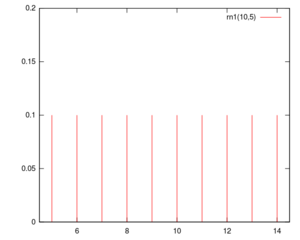Difference between revisions of "Rn1"
Jump to navigation
Jump to search
(cat) |
m (update ref to 3.6.6; de-stub since there's really not much that can be written about this) |
||
| (6 intermediate revisions by 4 users not shown) | |||
| Line 1: | Line 1: | ||
{{DISPLAYTITLE:rn1}} | {{DISPLAYTITLE:rn1}} | ||
| − | {{randomvariable|name=rn1(x,y)|graph=rn1.svg|caption=[[wikipedia:Probability mass function|Probability mass function]] of rn1(10,5) | + | {{randomvariable|name=rn1(<var>x</var>,<var>y</var>)|graph=rn1.svg|caption=[[wikipedia:Probability mass function|Probability mass function]] of rn1(10,5)|distribution=[[Wikipedia:discrete uniform distribution|uniform]]|mean={{sfrac|<var>x</var> − 1|2}} + <var>y</var>|stddev=sqrt({{sfrac|x<sup>2</sup> − 1|12}})}} |
| − | rn1(x, y | + | {{distinguish|rnl}} |
| + | '''rn1(<var>x</var>, <var>y</var>)'''{{refsrc|include/hack.h|497|nethack=3.6.6}} is a pseudo-random number macro used in ''NetHack'' when a result should be unweighted. It is equivalent to rn2(<var>x</var>) + <var>y</var>. The range of values is between <var>y</var> and <var>y</var> + <var>x</var> − 1 inclusive (that is, <var>y</var> ≤ rn1(<var>x</var>,<var>y</var>) < <var>x</var> + <var>y</var>). | ||
See also [[rn2]]. | See also [[rn2]]. | ||
| Line 8: | Line 9: | ||
<references/> | <references/> | ||
| − | |||
[[Category:Random number functions]] | [[Category:Random number functions]] | ||
| + | {{nethack-366}} | ||
Latest revision as of 17:35, 19 March 2022
| rn1(x,y) | |
|---|---|
 Probability mass function of rn1(10,5) | |
| Distribution | uniform |
| Mean | x − 12 + y |
| Standard deviation | sqrt(x2 − 112) |
- Not to be confused with rnl.
rn1(x, y)[1] is a pseudo-random number macro used in NetHack when a result should be unweighted. It is equivalent to rn2(x) + y. The range of values is between y and y + x − 1 inclusive (that is, y ≤ rn1(x,y) < x + y).
See also rn2.